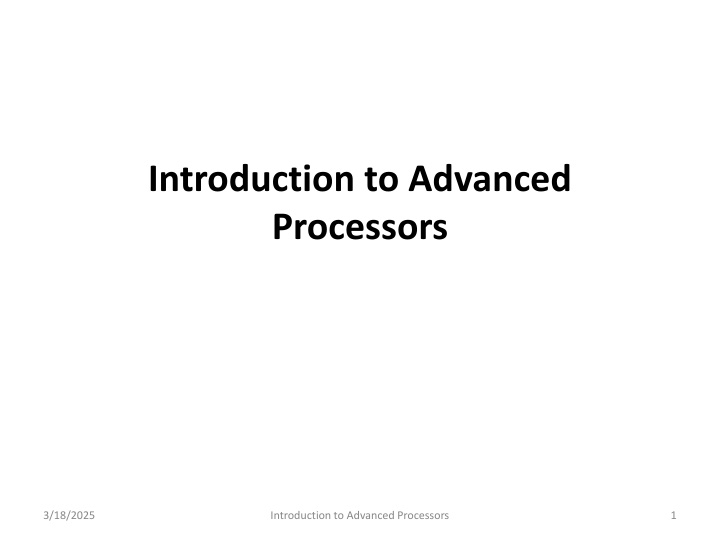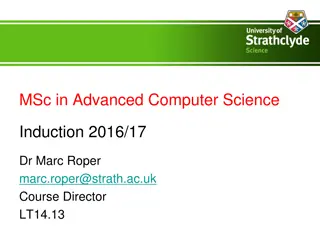
Advanced Processors: Internal Architecture and Features
Dive into the world of advanced processors with a focus on the 80286 CPU. Explore its internal architecture, operating modes, memory management, and performance enhancements compared to the older 8086. Discover how the 80286 revolutionized multiuser and multitasking systems.
Download Presentation

Please find below an Image/Link to download the presentation.
The content on the website is provided AS IS for your information and personal use only. It may not be sold, licensed, or shared on other websites without obtaining consent from the author. If you encounter any issues during the download, it is possible that the publisher has removed the file from their server.
You are allowed to download the files provided on this website for personal or commercial use, subject to the condition that they are used lawfully. All files are the property of their respective owners.
The content on the website is provided AS IS for your information and personal use only. It may not be sold, licensed, or shared on other websites without obtaining consent from the author.
E N D
Presentation Transcript
Introduction to Advanced Processors 3/18/2025 Introduction to Advanced Processors 1
Outline Features Internal Architecture of 80286 Interrupts of 80286 Signal Description of 80286 Real And Protected Mode Instruction set 3/18/2025 Introduction to Advanced Processors 2
The 80286 is the first member of the family of advanced microprocessors management and protection abilities. The 80286 CPU, with its 24-bit address bus is able to address 16 Mbytes of physical memory. Various versions of 80286 are available that runs on 12.5 MHz , 10 MHz and 8 MHz clock frequencies. It has been specially designed for multiuser and multitasking systems. 80286 is upwardly compatible with 8086 in terms of instruction set. memory with 3/18/2025 Introduction to Advanced Processors 3
It has 24 address lines and 16 data lines. 80286 have two operating modes namely real address mode and virtual address mode. In real address mode, the 80286 can address upto 1Mb of physical memory address like 8086. In virtual address mode, it can address up to 16 Mb of physical memory address space and 1 Gb of virtual memory address space. The virtual address mode is for multiuser and multitasking system. In VM, one user cannot interface with the other and also with OS. These features are called protection. The instruction set of 80286 includes the instructions of 8086 and 80186. 3/18/2025 Introduction to Advanced Processors 4
80286 have some extra instructions to support operating system and memory management. The performance of 80286 is five times faster than the standard 8086. Need for Memory Management The part of main memory in which the operating system and other system programs are stored is not accessible to the users. In view of this, an appropriate management of the memory system is required to ensure the smooth execution of the running process and also to ensure their protection. The memory management which is an important task of the operating system is supported by a hardware unit called memory management unit. 3/18/2025 Introduction to Advanced Processors 5
Internal Architecture of 80286 Register Organization of 80286 3/18/2025 Introduction to Advanced Processors 6
The 80286 CPU contains almost the same set of registers, as in 8086, namely 1. Eight 16-bit general purpose registers 2. Four 16-bit segment registers 3. Status and control registers 4. Instruction Pointer 3/18/2025 Introduction to Advanced Processors 7
3/18/2025 Introduction to Advanced Processors 8
Address Unit The address unit is responsible for calculating the physical address of instructions and data that the CPU wants to access. Also the address lines derived by this unit may be used to address different peripherals. The physical address computed by the address unit is handed over to the bus unit (BU) of the CPU. Bus unit Major function of the bus unit is to fetch instruction bytes from the memory. Instructions are fetched in advance and stored in a queue to enable faster execution of the instructions. 3/18/2025 Introduction to Advanced Processors 9
Instructions are fetched in advance and stored in a queue to enable faster execution of the instructions. The bus unit also contains a bus control module that controls the prefetcher module. These prefetched instructions are arranged in a 6-byte instructions queue. The 6-byte prefetch queue forwards the instructions arranged in it to the instruction unit (IU). 3/18/2025 Introduction to Advanced Processors 10
Instruction Unit The instruction unit accepts instructions from the prefetch queue and an instruction decoder decodes them one by one. The decoded instructions are latched onto a decoded instruction queue. Execution Unit The output of the decoding circuit drives a control circuit in the execution unit, which is responsible for executing the instructions received from decoded instruction queue. 3/18/2025 Introduction to Advanced Processors 11
The decoded instruction queue sends the data part of the instruction over the data bus. The EU contains the register bank used for storing the data as scratch pad, or used as special purpose registers. The ALU, the heart of the EU, carries out all the arithmetic and logical operations and sends the results over the data bus or back to the register bank. 3/18/2025 Introduction to Advanced Processors 12
Interrupts of 80286 The Interrupts of 80286 may be divided into three categories, 1. External or hardware interrupts 2. INT instruction or software interrupts 3. Interrupts generated internally by exceptions 3/18/2025 Introduction to Advanced Processors 13
1. Hardware and software interrupts The interrupts initiated by external hardware by sending an appropriate signal to the interrupt pin of the processor is called hardware interrupt. The interrupts initiated by applying appropriate signal to these pins are called hardware interrupts . 2. Software Interrupts The software interrupts are program instructions. These instructions are inserted at desired locations in a program. While running a program, if software interrupts instruction is encountered then the processor initiates an interrupt. The 8086 processor has 256 types of software interrupts. The software interrupt instruction is INT n, where n is the type number in the range 0 to 255. 3/18/2025 Introduction to Advanced Processors 14
3. Interrupts generated internally by exceptions While executing an instruction, the CPU may sometimes be confronted with a special situation because of which further execution is not permitted. While trying to execute a divide by zero instruction, the CPU detects a major error and stops further execution. In other words, an instruction exception is an unusual situation encountered during execution of an instruction that stops further execution. The return address from an exception, in most of the cases, points to the instruction that caused the exception. 3/18/2025 Introduction to Advanced Processors 15
Maskable Interrupt A maskable interrupt is a one that can be suppressed by software/code. That is to say, it may be ignored. Usually there are standard interrupt masking techniques for every processor, so that it may not be interrupted while performing some crucial task. Non Maskable interrupt Non-maskable interrupts are, those which can (and should) not be ignored. So events like critical hardware failure and system resets are attached to non-maskable interrupts. 3/18/2025 Introduction to Advanced Processors 16
If more than one interrupt signal comes simultaneously , they are processed according to their priority. Order Interrupt 1 Interrupt exception 2 Single step 3 NMI 4 Processor extension segment overrun 5 INTR 6 INT instruction 3/18/2025 Introduction to Advanced Processors 17
FUNCTION Divide error exception Single step interrupt NMI interrupt Breakpoint interrupt INTO detected overflow exception 4 BOUND range exceeded exception 5 Invalid opcode exception Processor extension not available exception 7 Intel reserved, do not use Processor extension error interrupt Intel reserved, do not use User defined Interrupt Number 0 1 2 3 6 8-15 16 17-31 32-255 3/18/2025 Introduction to Advanced Processors 18
Single Step Interrupt As in 8086, this is an internal interrupt that comes into action, if trap flag (TF) of 80286 is set. The CPU stops the execution after each instruction cycle. So, that the register contents (including flag register), the program status word and memory, etc. may be examined at the end of each instruction execution. This interrupt is useful for troubleshooting the software. An interrupt vector type 01 is reserved for this interrupt. 3/18/2025 Introduction to Advanced Processors 19
Flag Register New to 286 3/18/2025 Introduction to Advanced Processors 20
IOPL Input Output Privilege Level flags (bit D12 and D13) IOPL is used in protected mode operation to select the privilege level for I/O devices. NT Nested task flag (bit D14) -When set, it indicates that one system task has invoked another through a CALL instruction. 3/18/2025 Introduction to Advanced Processors 21
Signal Description of 80286 CLK: This is the system clock input pin. The clock frequency applied at this pin is divided by two internally and is used for deriving fundamental timings for basic operations of the circuit. The clock is generated using 8284 clock generator. D15-D0 : These are sixteen bidirectional data bus lines. A23-A0 : These are the physical address output lines used to address memory or I/O devices. The address lines A23 - A16 are zero during I/O transfers. BHE : This output signal, as in 8086, indicates that there is a transfer on the higher byte of the data bus (D15 D8) . 3/18/2025 Introduction to Advanced Processors 22
S1 , S0 : These are the active-low status output signals which indicate initiation of a bus cycle. M/ IO : This output line differentiates memory operations from I/O operations. If this signal is it 0 indicates that an I/O cycle or INTA cycle is in process and if it is 1 it indicates that a memory or a HALT cycle is in progress. COD/ INTA : This output signal, in combination with M/ IO signal and S1 , S0 distinguishes different memory, I/O and INTA cycles. LOCK : This active-low output pin is used to prevent the other masters from gaining the control of the bus for the current and the following bus cycles. 3/18/2025 Introduction to Advanced Processors 23
3/18/2025 Introduction to Advanced Processors 24
3/18/2025 Introduction to Advanced Processors 25
READY This active-low input pin is used to insert wait states in a bus cycle, for interfacing low speed peripherals. This signal is neglected during HLDA cycle. HOLD and HLDA This pair of pins is used by external bus masters to request for the control of the system bus (HOLD) and to check whether the main processor has granted the control (HLDA) or not, in the same way as it was in 8086. INTR : Through this active high input, an external device requests 80286 to suspend the current instruction execution and serve the interrupt request. Its function is exactly similar to that of INTR pin of 8086. 3/18/2025 Introduction to Advanced Processors 26
NMI : The Non-Maskable Interrupt request is an active- high, edge-triggered input that is equivalent to an INTR signal of type 2. No acknowledge cycles are needed to be carried out. PEREG and PEACK (Processor Extension Request and Acknowledgement) Processor extension refers to coprocessor. This pair of pins extends the memory management and protection capabilities of 80286 to the processor extension 80287. The PEREQ input requests the 80286 to perform a data operand transfer for a processor extension. The PEACK active-low output indicates to the processor extension that the requested operand is being transferred. 3/18/2025 Introduction to Advanced Processors 27
BUSY and ERROR : Processor extension BUSY and ERROR active-low input signals indicate the operating conditions of a processor extension to 80286. The BUSY goes low, indicating 80286 to suspend the execution and wait until the BUSY become inactive. In this duration, the processor extension is busy with its allotted job. Once the job is completed the processor extension drives the BUSY input high indicating 80286 to continue with the program execution. An active ERROR signal causes the 80286 to perform the processor extension interrupt while executing the WAIT and ESC instructions. The active ERROR signal indicates to 80286 that the processor extension has committed a mistake and hence it is reactivating the processor extension interrupt. 3/18/2025 Introduction to Advanced Processors 28
CAP : A 0.047 f, 12V capacitor must be connected between this input pin and ground to filter the output of the internal substrate bias generator. For correct operation of 80286 the capacitor must be charged to its operating voltage. Till this capacitor charges to its full capacity, the 80286 may be kept stuck to reset to avoid any spurious activity. Vss : This pin is a system ground pin of 80286. Vcc : This pin is used to apply +5V power supply voltage to the internal circuit of 80286. RESET The active-high RESET input clears the internal logic of 80286, and reinitializes it. The active-high reset input pulse width should be at least 16 clock cycles. The 80286 requires at least 38 clock cycles after the trailing edge of the RESET input signal, before it makes the first opcode fetch cycle. 3/18/2025 Introduction to Advanced Processors 29
The 80286 CPU can operate in two modes: (1) Real address mode and (2) Protected virtual address mode. Instruction The Instruction Pointer or IP (also called the program counter in 8085) is a processor register that indicates where the computer is in its instruction sequence. In 80286 instruction pointer holds the address of the next instruction to be executed. In most processors, the instruction pointer is incremented automatically after fetching a program instruction, so that instructions are normally retrieved sequentially from memory, with certain instructions, such as branches, jumps and subroutine calls and returns, interrupting the sequence by placing a new value in the program counter. Pointer: 3/18/2025 Introduction to Advanced Processors 30
REAL ADDRESSING MODE In real addressing mode of operation; the 80286 acts as a fast 8086. The 80286 addresses only 1 Mbytes of physical memory using A0-A19. The lines A20-A23 are not used by the internal circuit of 80286 in this mode. In real address mode, while addressing the physical memory, the 80286 uses BHE along with A0-A19. The 20- bit physical address is again formed in the same way as that in 8086. The contents of segment registers are used as segment base addresses. The other registers, depending upon the addressing mode, contain the offset addresses. The address formation in real address mode is shown in Fig. 3/18/2025 Introduction to Advanced Processors 31
3/18/2025 Introduction to Advanced Processors 32
The 80286 reserves two fixed areas of physical memory for system initialization and interrupt vector table. In the real mode the first 1 KB of memory starting from address 00000H to 003FFH is reserved for interrupt vector table. Also the addresses from FFFF0H to FFFFFH are reserved for system initialization. The program execution starts from FFFF0H after reset and initialization. The interrupt vector table of 80286 is organized in the same way as that of 8086. Some of the interrupt types are reserved for exceptions, single-stepping and processor extension segment overrun, etc. When the 80286 is reset, it always starts its execution in real address mode, wherein it performs the following It initializes the IP and other registers of 80286, initializes the peripheral, enables interrupts, sets up descriptor tables and then it prepares for entering the protected virtual address mode. functions: - 3/18/2025 Introduction to Advanced Processors 33
2. PROTECTED VIRTUAL ADDRESS MODE (PVAM) The 80286 is the first processor to support the concepts of virtual memory and memory management. Virtual memory does not exist physically it still appears to be available within the system. The concept of virtual memory is implemented using physical memory that the CPU can directly access the secondary memory that is used as storage for data and program, which are stored in secondary memory initially. The segment of the program or data, required for actual execution at that instant, is fetched from the secondary memory into physical memory. After the execution of this fetched segment, the next segment required for further execution is again fetched from the secondary memory, while the results of the executed segment are stored back into the secondary memory for further references. 3/18/2025 Introduction to Advanced Processors 34
This continues till the complete program is executed. During the execution, the partial results of the previously executed portions are again fetched into the physical memory, if required for further execution. The procedure of fetching the chosen program segments or data from the secondary storage into the physical memory is called memory swapping. The procedure of storing back the partial results or data back on to the secondary storage is called unswapping. 3/18/2025 Introduction to Advanced Processors 35
The 80286 is able to address 1Gbyte of virtual memory per In case of huge programs (in general greater than physical memory in size), they are divided in either smaller segments or pages which are arranged in appropriate sequence and are swapped in or out of primary memory as per the requirements, for execution of the complete task. program. These segments or pages have been associated with a data structure called as a descriptor. The descriptor contains information of the program segment or page. 3/18/2025 Introduction to Advanced Processors 36
For example a school teacher may stack all the answer sheets solved by the students in a bundle and attached a small slip of paper with it containing information like name, subject, class, date and year of examination, his own name, number of students, present and absent, roll numbers of absent students etc. From this information return on the small slip of paper a third person can easily know the details of the particular bundle of papers. This information may further be used by anybody for preparing a detailed analysis of results of all subjects. 3/18/2025 Introduction to Advanced Processors 37
The data structure descriptor is essentially one such identifier of a particular program segment or page. A set of such descriptors arranged in a proper sequence describes the complete program. In case of multiprogramming environment many of such sets of descriptors may be available in the system at All this sets of descriptors (descriptors table) are prepared and managed by the operating system. an instant of time 3/18/2025 Introduction to Advanced Processors 38
Thus corresponding to different types of program segments there may be different type of For example for data segments there may be data segment descriptors, for code segments there may be code segment descriptors, for system programs there are system segments descriptors, for subroutines and interrupt service routines there are gate descriptors or interrupt descriptors etc. descriptors. 3/18/2025 Introduction to Advanced Processors 39
PHYSICAL ADDRESS CALCULATION IN PROTECTED VIRTUAL MODE (PVAM) In PVAM, the 80286 uses the 16-bit content of a segment register as a selector to address a descriptor table stored in physical memory. The descriptor is a block of contiguous memory locations containing information of a segment, like segment base address, segment limit, segment type, privilege level, segment availability in physical memory, descriptor type and segment used by another task. The base address, i.e. the starting location of a segment is important descriptor The segment limit indicates the maximum size of a segment. Thus using the base address of a segment and the segment limit, one can determine the last location in the segment. information. 3/18/2025 Introduction to Advanced Processors 40
Similarly, each segment has a type and its privilege level, which indicate the importance The privilege level indicates the privilege measure of a segment. A segment with lower privilege level will not be allowed to access another segment having higher privilege, thus offering protection to the segment from the unauthorized accesses. Moreover, a certain segment may or may not be present in the physical memory at a given time instant. This information is also stored in Finally, important information, i.e. whether the segment has been accessed by another task in the past, is also stored in the segment descriptor. This information helps in deciding, whether the segment should be unswapped from the physical memory or not. of the segment. a descriptor. 3/18/2025 Introduction to Advanced Processors 41
Instruction set Same as 8086 with some additional instructions 3/18/2025 Introduction to Advanced Processors 42
Additional Instructions of Intel 80286 Sl no 1. Instruction Purpose CLTS Clear the task switched bit 2. LDGT Load global descriptor table register 3. SGDT Store global descriptor table register 4. LIDT Load interrupt descriptor table register 5. SIDT Store interrupt descriptor table register 6. LLDT Load local descriptor table register 7. SLDT Store local descriptor table register 8. LMSW Load machine status register 9. SMSW Store machine status register Introduction to Advanced Processors 3/18/2025 43
Sl no Instruction Purpose 10. LAR Load access rights 11. LSL Load segment limit 12. SAR Store access right 13. ARPL Adjust requested privilege level 14. VERR Verify a read access 15. VERW Verify a write access 3/18/2025 Introduction to Advanced Processors 44
EXPECTED QUESTIONS K1 Level Remember What is the necessity of Memory Management unit? What is the importance of IOPL signal in 80286? Define swapping and unswapping process in 80286. List some of the special instructions in 80286. K2 Level-Understand Outline the features of 80286. Summarize the interrupts in 80286 Compare hardware and software interrupts. Summarize the functions of the following signals in 80286. PEREG, PEACK, READY,HOLD and HLDA Summarize about the Interrupts generated internally by exceptions. 3/18/2025 Introduction to Advanced Processors 45
EXPECTED QUESTIONS Descriptive Questions K2 Level - Understand 1.Explain in details about architecture, interrupt and signal of Advanced processor 80286. 2.Demonstrate the architecture of 80286 with neat diagram. 3.Summarize about architecture and different modes of operation in 80286. signal and internal 3/18/2025 Introduction to Advanced Processors 46






















